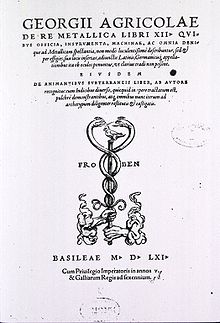
Back دي ري ميتاليكا Arabic De re metallica Catalan De re metallica libri XII Czech De re metallica Danish De re metallica German De re metallica Esperanto De re metallica Spanish De re metallica Finnish De re metallica Italian De re metallica Dutch
 Title page of 1561 edition | |
| Author | Georgius Agricola |
|---|---|
| Translator | Herbert Hoover Lou Henry Hoover |
Publication date | 1556 |
Published in English | 1912 |
| ISBN | 0-486-60006-8 |
| OCLC | 34181557 |
De re metallica (Latin for On the Nature of Metals [Minerals]) is a book in Latin cataloguing the state of the art of mining, refining, and smelting metals, published a year posthumously in 1556 due to a delay in preparing woodcuts for the text. The author was Georg Bauer, whose pen name was the Latinized Georgius Agricola ("Bauer" and "Agricola" being respectively the German and Latin words for "farmer"). The book remained the authoritative text on mining for 180 years after its publication. It was also an important chemistry text for the period and is significant in the history of chemistry.[1]
Mining was typically left to professionals, craftsmen and experts who were not eager to share their knowledge. Much experiential knowledge had been accumulated over the course of time. This knowledge was consecutively handed down orally within a small group of technicians and mining overseers. In the Middle Ages these people held the same leading role as the master builders of the great cathedrals, or perhaps also alchemists. It was a small, cosmopolitan elite within which existing knowledge was passed on and further developed but not shared with the outside world. Only a few writers from that time wrote anything about mining itself. Partly, that was because this knowledge was very difficult to access. Most writers also found it simply not worth the effort to write about it. Only in the Renaissance did this perception begin to change. With the improved transport and the invention of the printing press knowledge spread much more easily and faster than before. In 1500, the first printed book dedicated to mining engineering, called the Nützlich Bergbüchleyn ("The Useful Little Mining Book”) by Ulrich Rülein von Calw, was published. The most important works in this genre were, however, the twelve books of De Re Metallica by Georgius Agricola, published in 1556.
Agricola had spent nine years in the Bohemian town of Joachimsthal (now Jáchymov in the Czech Republic). After Joachimsthal, he spent the rest of his life in Chemnitz in Saxony, another prominent mining town in the Ore Mountains.
The book was greatly influential, and for more than a century after it was published, De Re Metallica remained a standard treatise used throughout Europe. The German mining technology it portrayed was acknowledged as the most advanced at the time, and the metallic wealth produced in German mining districts was the envy of many other European nations. The book was reprinted in a number of Latin editions, as well as in German and Italian translations. Publication in Latin meant that it could be read by any educated European of the time. The 292 superb woodcut illustrations and the detailed descriptions of machinery made it a practical reference for those wishing to replicate the latest in mining technology.[2]
The drawings from which the woodcuts were made were done by an artist in Joachimsthal named Blasius Weffring or Basilius Wefring. The woodcuts were then prepared in the Froben publishing house by Hans Rudolf Manuel Deutsch and Zacharias Specklin.[3]
In 1912, the first English translation of De Re Metallica was privately published in London by subscription. The translators were Herbert Hoover, a mining engineer (and later President of the United States),[4] and his wife, Lou Henry Hoover, a geologist and Latinist. The translation is notable not only for its clarity of language, but for the extensive footnotes, which detail the classical references to mining and metals. Subsequent translations into other languages, including German, owe much to the Hoover translations, as their footnotes detail their difficulties with Agricola's invention of several hundred Latin expressions to cover Medieval German mining and milling terms that were unknown to classical Latin. The most important translation—outside English—was the one published by the Deutsches Museum in Munich.[5]
- ^ Musson; Robinson (1969). Science and Technology in the Industrial Revolution. University of Toronto Press. pp. 26, 29. ISBN 9780802016379.
- ^ Eric H. Ash, Power, Knowledge, and Expertise in Elizabethan England (Baltimore: Johns Hopkins University Press, 2004) 23.
- ^ Owen Hannaway, “Herbert Hoover and Georgius Agricola: The Distorting Mirrors of History,” Bulletin for the History of Chemistry 12 (1992), 3-10.
- ^ Hansen, Roger D. (2005). "Water Wheels" (PDF). waterhistory.org. Archived (PDF) from the original on 14 April 2022.
- ^ Georg Agricola, Zwolf Bücher vom Berg- und Hüttenwesen, (Berlin 1928).
© MMXXIII Rich X Search. We shall prevail. All rights reserved. Rich X Search